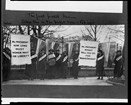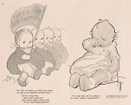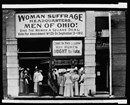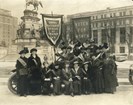Series edited by Tamara Gaskell. The year 2020 marks a significant centennial: ratification of a federal constitutional amendment that barred states from excluding women from the electorate solely on the basis of their sex. We pay tribute to the tens of thousands of women who envisaged a government in which men and women had equal voice and who, through agitation and persistent mobilization of citizens, brought about that change. This was a long fight.
-
Article 1: Looking for a Right to Vote: Introducing the Nineteenth Amendment

The year 2020 marks a significant centennial: ratification of a federal constitutional amendment that barred states from excluding women from the electorate solely on the basis of their sex. We pay tribute to the tens of thousands of women who envisaged a government in which men and women had equal voice and who, through agitation and persistent mobilization of citizens, brought about that change. Read more
-
Article 2: The Necessity of Other Social Movements to the Struggle for Woman Suffrage

American women’s struggle for the vote, a profoundly important chapter in the story of American democracy, did not unfold as an independent plot. Instead, the woman suffrage movement emerged from and was continually fed by other social movements and political causes Read more
-
Article 3: Flexing Feminine Muscles: Strategies and Conflicts in the Suffrage Movement

Winning women’s right to vote took the energies of three generations of women, the support of a few men, and nearly a century to accomplish. The process necessitated that suffragists ally with groups holding other priorities—abolitionists, temperance and maternalist reformers, and eventually political and third-party reformers—in their effort to broaden support. Read more
-
Article 4: Anti-Suffragism in the United States

From the 1840s, when six New York women protested taxation without representation, through the 1920s, after ratification of the Nineteenth Amendment, supporters of women’s right to vote met opposition. Read more
-
Article 5: African American Women and the Nineteenth Amendment

African American women, though often overlooked in the history of woman suffrage, engaged in significant reform efforts and political activism leading to and following the ratification in 1920 of the Nineteenth Amendment, which barred states from denying American women the right to vote on the basis of their sex. They had as much—or more—at stake in the struggle as white women. Read more
-
Article 6: From Mannish Radicals to Feminist Heroes: Suffragists in Popular Culture

When you think of the women who advocated for the right to vote, which images come to mind? Perhaps you conjure up Susan B. Anthony’s profile on the dollar coin or photographs of suffragists picketing the White House. Today, the popularity of these pictures reflects the growing interest in past female leaders. However, in the nineteenth century, many Americans mocked suffragists as ugly, masculine women. Read more
-
Article 7: Woman Suffrage in the West

Women of the West were the first in the United States to enjoy full voting rights. As new territories and states organized, many considered, and most granted, women the right to vote. Decades before passage of the Nineteenth Amendment, western women voted and served in public office. In the diverse West, woman suffragists campaigned across mountains, plains, and deserts, finding common cause with a variety of communities and other political movements. Read more
-
Article 8: Woman Suffrage in the Midwest

Unlike other regions of the country where it is possible to see clear patterns in the woman suffrage story, such as the West with its early successes or the South where racism impeded the expansion of voting rights, the Midwest has no single dominant narrative of the woman suffrage campaign. Read more
-
Article 9: Woman Suffrage in New England

Although many histories of woman suffrage use the 1848 convention in Seneca Falls, New York as a starting point for the movement, New York State was not the only place women fought for the right to vote during the mid-nineteenth century. Women and men from the New England states of Maine, Vermont, New Hampshire, Massachusetts, Connecticut, and Rhode Island also mobilized for women’s rights in the 1840s. Read more
-
Article 10: Woman Suffrage in the Mid-Atlantic

Women in the mid-Atlantic states were at the forefront of the woman suffrage movement at its inception in the mid-nineteenth century, and they provided much of the leadership that would ultimately ensure ratification of the Nineteenth Amendment in 1920. Read more
-
Article 11: Woman Suffrage in the Southern States

Although the woman suffrage movement emerged later and had fewer victories in the South than elsewhere, southern women could claim responsibility for the decisive vote leading to the ratification of the 19th Amendment to the Constitution, declaring that voting rights could not be restricted “on account of sex.” In the summer of 1920, the amendment had passed Congress and been ratified by thirty-five of the necessary thirty-six states, and all eyes turned to Tennessee. Read more
-
Article 12: The International History of the US Suffrage Movement

The history of the US woman suffrage movement is usually told as a national one. It begins with the 1848 Seneca Falls convention; follows numerous state campaigns, court battles, and petitions to Congress; and culminates in the marches and protests that led to the Nineteenth Amendment. This narrative, however, overlooks how profoundly international the struggle was from the start. Read more
-
Article 13: Commemorating Suffrage: Historic Sites and Women’s Right to Vote

Women have always been leaders in the movement for historic preservation. Until the late twentieth century, however, very few sites relating to women’s history—and even fewer relating to woman suffrage—were formally identified or preserved. Read more
-
Article 14: Beyond 1920: The Legacies of Woman Suffrage

The Nineteenth Amendment officially eliminated sex as a barrier to voting throughout the United States. It expanded voting rights to more people than any other single measure in American history. And yet, the legacy of the Nineteenth Amendment, in the short term and over the next century, turned out to be complicated. It advanced equality between the sexes but left intersecting inequalities of class, race, and ethnicity intact. Read more
